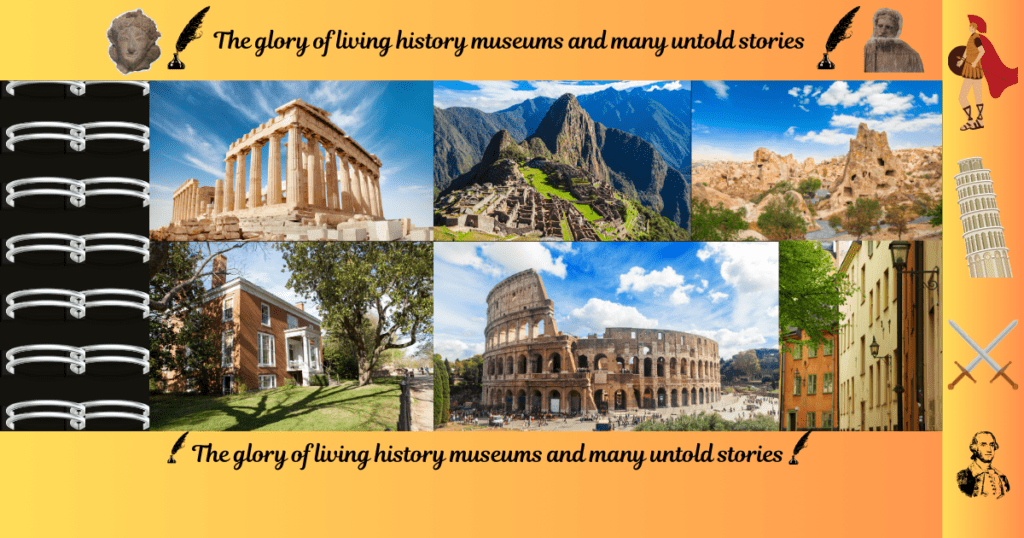Table of Contents
Introduction:
Time moves, and with every passing moments each historical establishments wants to appeal something unexplained that as a traveler you will come to know once you step into a transformative tour.From the ancient history of the past till the evolution period of the modern dynasty, the world has adopted so many drastic changes by significantly understanding the pinpoints where the past can quite often consume present attention to go back to time further so that its golden glory reenacted in the most captivating way possible in front of curious, and enthusiastic historians.
There is always something to cherish about the past by pushing back at a time and immersing yourself in the rich tapestry of history that teaches you something in every passing moment of each historic landmark. Historical landmarks and their existence are distinctive, representing portals of bygone eras, allowing us to connect with the past in a most profound and meaningful way and propelling us to integrate modern society with its highlighting marvels.
So, if you want to feel proud of yourself by exploring some magnificent sculptures,intricate marvels and artwork from fading days, overshadowed by the hype of modern skyscrapers, then embark on a journey through time by escaping to some glittering destinations around the globe that promise to leave you spellbound. In this blog, we will discuss the importance of historic sites and leaving history museums that proudly hold our cultural heritage and how tourism flourishes through their grand, orthodox establishments and prominent architecture where time pushes us back to glare at history.
The Acropolis of Athens, Greece:
On one hand, we are preserving all the historical significance in a safe corner of our memorial hall, and on the other hand, by visiting those historical landscapes, we are spreading the message of cultural harmony and its historical importance worldwide. The Acropolis of Athens is a historical gem cuddled on the lap of a limestone hill surrounded by a rocky outcrop.
The place is an absolute paradise overlooking the city of Athens and a wondrous UNESCO World Heritage site. It was established in the 5th century BCE and stands as a testament to the glory of ancient Greece. A massive monument comprised of rock structures holds its position in symmetry. Since the Acropolis of Athens is the home of too many historical masterpieces, holding its pose stylishly like a Greek god in the heart of beautiful Athens. The allure-miracle sites of the Acropolis are the epitome of historical monarchy and offer a glimpse into the achievements of one of the world’s greatest civilizations.
The sculpting work of this iconic monument is so lively and great that it has stood nicely spotless for over two decades. The Acropolis is one of the most appealing and complete examples of ancient Greek monuments that existed during bygone time, as it contains a collection of buildings, of which the Parthenon is the most striking, glittering on top of the hill.
During the battle of Athena and Posideon in medieval days, soldiers dug so many caves to find the gateways of escape roots with their traces rediscovered in the modern day. But after so many highs and lows, the architecture and art found in Acropolis is so inspiring and mesmerizing that it easily captivates visitors worldwide. Acropolis represents the God Athena, and she lives in a prestigious position in people’s faith. Her role is simple: to watch over and protect the city and its people from unprecedented invader encounters.
The Acropolis is an openly represented museum, and all its historical marvels are exceptional; visitors are not allowed to touch them, and even visitors are not allowed to walk inside the temple areas. Since the Acropolis is the torchbearer of Greece, Athens’s ancient history and heritage are so bustling and as expected that nobody wants to miss any moment to enjoy its eye-catching beauty.
April to mid-June or September to October are the off-peak seasons and the best time to visit. So, wander among the marble columns and statues and imagine yourself in the bustling agora, where philosophers once debated with citizens gathered to shape the future destiny.
Machu Picchu, Peru:
Also known as the abundant city of the Incas, Machu Picchu is an iconic citadel located in the eastern corridor of southern Peru. Machu Picchu is a mist-shrouded peak in the Andes mountain range and was rediscovered in 1911, representing a marvel of Incan engineering and ingenuity.
The architecture of Machu Picchu is massive; built with huge stone slabs put together in symmetry, it blends easily with the pristine natural beauty at its backdrop where history pushes us way back on old time. Visitors can climb the top hill of Huyana Picchu and take pictures of the Urubamba River far below, which has a bend towards the arch of narrow mountain passages. Built-in the age old time of 15th century and buried just a year later, this “Lost City of the Incas” remained camouflaged from the outside world.
Set almost 7000 feet above sea level, Machu Picchu is the latest archaeological site in the world due to its unprecedented stony power and craftsmanship, reflecting in its awe-inspiring ruin existence of past time. Thanks to its spiritual significance, Machu Picchu is a site that emits healing and transformative energy in its wing span and vibes. Visitors can climb the stiff Inca Trail hikes or take a scenic train journey to the ancient citadel for an unforgettable experience.
There is something to enjoy for everyone in one of anicient time Peru’s stone masonry that contemplates the mysteries of its elegant past and drives you to an enigmatic age old time off-the-beaten-path adventure that enriches your life meaningfully.
Colonial Williamsburg, Virginia, USA:
One of the world’s largest living history museums, spread over 301 acres and featuring 75 iconic sites, Colonial Williamsburg reenacts the history that precisely recreates the life of 18th-century Virginia. A premium center of preservation famed as Colonial Williamsburg, Virginia, USA, interprets America’s colonial history and allows people to expertly understand the history of America and their fight for revolution success story as a nation.
Stroll along cobbled streets lined with meticulously restored buildings, where skillful artisans orchestrated with colorful costumes represent the history of ancient colonial lives most impressively, with the honest purpose of historical reenactments by demonstrating the history in its natural habitat. Visit the Governor’s Palace and explore the shops and taverns that help you gain deep insight into the daily lives of people who have lived there for generations and played a vital role in shaping the destiny of a fledgling nation.
So, get yourself to indulge in and embark on a journey to one of the largest outdoor living museums by immersing yourself in the vast array of educational experiences, of which the road to wisdom gateway will open up from Colonial Williamsburg, Virginia, USA.
The Colosseum, Rome, Italy:
Situated in the heart of the vibrant city of Rome, Italy, the Colosseum, the most iconic symbol of the Roman Empire, was commissioned by Emperor Vespasian in 70–72 AD. The Colosseum is renowned as the world’s largest elliptical amphitheater. Known for its creative entertainment venues, the Colosseum once hosted gladiator fights, animal hunts, and even naval mock fighting, specially designed to entertain the masses by standing tall and proud with its stubborn legacy.
The Colosseum remains the symbol of mighty Roman culture, which illustrates creativity and beauty, is full of resourcefulness, and reenacts its history in front of modern civilization in an awe-inspiring manner. One of the designated UNESCO World Heritage Sites draws attention from visitors all across the globe due to its captivating architectural craftsmanship and colossal structures that stand approx. 157 cm high.
The Colosseum remains a symbol of Roman kingship presented by the theme of genius, power, and brutality, commonly known as the Flavian Amphitheatre, which generates significant tourism revenue for the Italian government. The Colosseum is one of the most preserved amphitheaters worldwide that still manages to convey its charm to visitors century after century due to its sheer scale of structure, where crowds gather in large queues to imagine roaring like cheerers as if they fight an extreme battle for gladiators, which is about to begin till one concurs with another by standing amidst the ruins of this supernatural architectural masterpiece.
Skansen Open-Air Museum, Stockholm, Sweden:
Founded in 1891, the Skansen Open Air Museum in Sweden highlights a historic century-old Swedish impactful tradition. Experience the charm of rural Sweden at Skansen Open Air Museum, the world’s first open-air museum that reflects the real sense of the past and how Swedes once lived and adopted the style of living according to the changing times.
Spread across 75 acres on the island of Djurgarden, Stockholm, Skansen is one of the oldest open-air museums and zoos, where you can discover wild animals such as bears, wolves, and moose roaming in their natural habitat, as well as historic buildings from all over Sweden. People of all different age groups dressed in character to glorify the gone-by periods demonstrate traditional crafts and promote trades in this neck of the woods.
It’s worth visiting the Skansen Open Air Museum, where you can spend time at different stops such as the glassblower hut, rustic bakery, photo shootouts with a standing gigantic wooden Dala horse, setting an open camp over a picnic area, and enjoying your day. The weather is pleasant and mild from June to August, making the place ideal for outdoor outings. So, embark on a journey from wooden farmsteads to Sami encampments by visiting this living museum that reenacts the history with some fascinating glimpses into the cultural heritage of yesteryear.
Key Takeaways:
A Personal Connection to History:
Visiting living history museums and historical sites allows readers to emotionally and intellectually connect with history in a way that offline reading of books or e-learning alone cannot fulfill. These immersive learning experiences transport visitors back in time by giving them a deeper understanding of how past events and cultures have shaped the world with the help of living history by redefining the way we live today.
Diverse Narratives across Cultures and Regions:
Living History museums glorify the rich diversity of historic sites and museums worldwide. From ancient ruins to modern monuments, they show how history is not one-size-fits-all but the importance of different regions and cultures that offer distinct stories that are crucial to understanding global history in a more holistic way.
Engagement beyond Traditional Learning:
Traditional classroom learning often lacks the excitement and depth of narratives of real firsthand experiences. Time Flies rapidly, emphasizing how traveling to living history sites transforms historical education, offering dynamic, experiential learning to travelers that engages all the senses where history-making scenes come alive in front of eyes in a way that textbooks cannot replicate.
The Role of Preservation in Shaping Our Future:
Historic sites and living museums play an essential role in preserving the stories, architecture, and cultures of the past. Preservation is significant as it underscores the moral value of protecting these locations, ensuring that future generations can learn from them by fostering their curiosity to spread the importance of living history museum preservations through global conversations.
Conclusion:
History repeats itself, and if you’re a history buff, a cultural enthusiast, or simply a curious traveler seeking new experiences of historical diversity, then these five glorified sites and living history museums promise to inspire, educate, and captivate visitors of all ages and impress with an awe-inspiring effect.
So pack your bags, prepare to step back in time, and embark on a timeless journey that reenacts the old-day historical phenomenon in the most captivating way.
FAQs
FAQ 1: What are the benefits of visiting historical sites and living history museums?
Visiting historical sites and living history museums allows you to reconnect with history by immersing yourself in different cultures and eras. There are opportunities to gain hands-on experience by visiting historical events, enjoying authentic artifacts, and interacting with knowledgeable guides, which could perhaps help you to understand the meaning of history in a mindful way.
FAQ 2: How do I choose which historic sites to visit?
Planning is very significant so that you can choose the historic site you wish to visit. Start by considering the interest you crave to travel, whether it is ancient civilization, specific wars, or cultural heritage, and then plan your visit accordingly. Research sites that echo unique stories are renowned for their preservation, well-summarized philosophy, and narratives by checking visitor reviews and seeking recommendations from history enthusiasts to filter your options for travel.
FAQ 3: Are living history museums suitable for families with children?
Answer: For families and kids, a living history museum can be a place for real learning curves where people of all ages from family have a great chance to attach deeply to the living creation of history. Living history museums often provide interactive experiences, engaging performances, and educational activities tailored for children. These convivial environments make learning fun by sparking curiosity about history among younger visitors, making it an enjoyable outing for the whole family.
FAQ 4: What should I expect during a visit to a living history museum?
Answer: During your visit to the Living History Museum, you might see costumed interpreters who reenact daily life from the period being portrayed, where you have a great chance to participate in hands-on activities and feel the allure of historical episodes that unfold in front of you. Explore authentic buildings and attend demonstrations of historical crafts or trades. Each visit could offer a unique opportunity for visitors to step back in time to relax and learn through experience.
FAQ 5: How can I make the most of my trip to a historic site or museum?
Answer: It is noteworthy that you should make the most of your trip while visiting any historical epitomes that appeal to you to understand its philosophy and creative artifacts. To maximize your experience, plan, research the site’s history, schedule guided tours, and participate in any special events or workshops that you offer before you plan your trip. Bring a notebook or SLR high-megapixel camera to capture your thoughts and memories. Engaging with staff and asking meaningful questions could enhance your understanding by making your travel more enjoyable and worth it.







